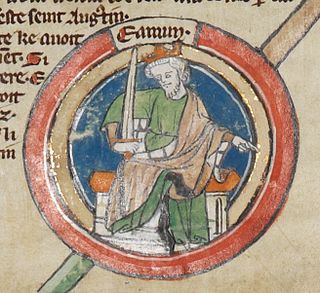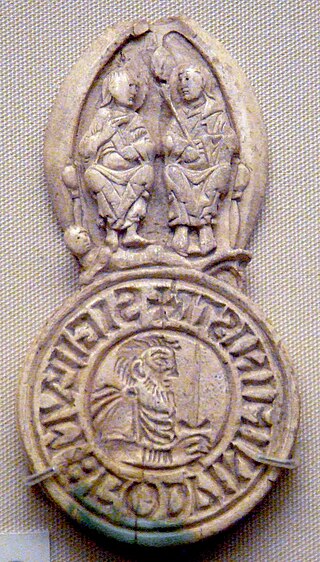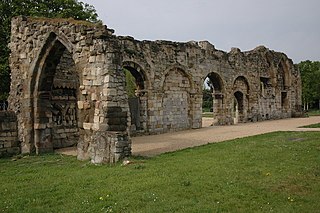
Edmund I or Eadmund I was King of the English from 27 October 939 until his death. He was the elder son of King Edward the Elder and his third wife, Queen Eadgifu, and a grandson of King Alfred the Great. After Edward died in 924, he was succeeded by his eldest son, Edmund's half-brother Æthelstan. Edmund was crowned after Æthelstan died childless in 939. He had two sons, Eadwig and Edgar, by his first wife Ælfgifu, and none by his second wife Æthelflæd. His sons were young children when he was killed in a brawl with an outlaw at Pucklechurch in Gloucestershire, and he was succeeded by his younger brother Eadred, who died in 955 and was followed by Edmund's sons in succession.

Eadwig was King of England from 23 November 955 until his death. He was the elder son of Edmund I and his first wife Ælfgifu, who died in 944. Eadwig and his brother Edgar were young children when their father was killed trying to rescue his seneschal from attack by an outlawed thief on 26 May 946. As Edmund's sons were too young to rule he was succeeded by his brother Eadred, who suffered from ill health and died unmarried in his early 30s.

Edgar was King of England from 959 until his death. He became king of all England on his brother's death. He was the younger son of King Edmund I and his first wife Ælfgifu. A detailed account of Edgar's reign is not possible, because only a few events were recorded by chroniclers and monastic writers were more interested in recording the activities of the leaders of the church.

Æthelwulf was King of Wessex from 839 to 858. In 825, his father, King Ecgberht, defeated King Beornwulf of Mercia, ending a long Mercian dominance over Anglo-Saxon England south of the Humber. Ecgberht sent Æthelwulf with an army to Kent, where he expelled the Mercian sub-king and was himself appointed sub-king. After 830, Ecgberht maintained good relations with Mercia, and this was continued by Æthelwulf when he became king in 839, the first son to succeed his father as West Saxon king since 641.

Æthelberht was the King of Wessex from 860 until his death in 865. He was the third son of King Æthelwulf by his first wife, Osburh. Æthelberht was first recorded as a witness to a charter in 854. The following year Æthelwulf went on pilgrimage to Rome and appointed his oldest surviving son, Æthelbald, as king of Wessex while Æthelberht became king of the recently conquered territory of Kent. Æthelberht may have surrendered his position to his father when he returned from pilgrimage, but resumed the south-eastern kingship when his father died in 858.

Eadred was King of the English from 26 May 946 until his death. He was the younger son of Edward the Elder and his third wife Eadgifu, and a grandson of Alfred the Great. His elder brother, Edmund, was killed trying to protect his seneschal from an attack by a violent thief. Edmund's two sons, Eadwig and Edgar, were then young children, so Eadred became king. He suffered from ill health in the last years of his life and he died at the age of a little over thirty, having never married. He was succeeded successively by his nephews, Eadwig and Edgar.

In Anglo-Saxon England, a thegn or thane was an aristocrat who owned substantial land in one or more counties. Thanes ranked at the third level in lay society, below the king and ealdormen. Thanage refers to the tenure by which lands were held by a thane as well as the rank.

Ealdorman was a term in Anglo-Saxon England which originally applied to a man of high status, including some of royal birth, whose authority was independent of the king. It evolved in meaning and, in the eighth century, was sometimes applied to the former kings of territories which had submitted to great powers, such as Mercia. In Wessex in the second half of the ninth century, it meant the leaders of individual shires appointed by the king. By the tenth century, ealdormen had become the local representatives of the West Saxon king of England. Ealdormen would lead in battle, preside over courts, and levy taxation. Ealdormanries were the most prestigious royal appointments, the possession of noble families and semi-independent rulers. Their territories became large, often covering former kingdoms, such as Mercia or East Anglia. Southern ealdormen often attended court, reflecting increasing centralisation of the kingdom, but the loyalty of northern ealdormen was more uncertain. In the eleventh century, the term eorl, today's earl, replaced that of ealdorman, but this reflected a change in terminology under Danish influence rather than a change in function.

Æthelred, Lord of the Mercians became ruler of English Mercia shortly after the death or disappearance of its last king, Ceolwulf II in 879. Æthelred's rule was confined to the western half, as eastern Mercia was then part of the Viking-ruled Danelaw. His ancestry is unknown. He was probably the leader of an unsuccessful Mercian invasion of Wales in 881, and soon afterwards he acknowledged the lordship of King Alfred the Great of Wessex. This alliance was cemented by the marriage of Æthelred to Alfred's daughter Æthelflæd.
The word seneschal can have several different meanings, all of which reflect certain types of supervising or administering in a historic context. Most commonly, a seneschal was a senior position filled by a court appointment within a royal, ducal, or noble household during the Middle Ages and early Modern period – historically a steward or majordomo of a medieval great house. In a medieval royal household, a seneschal was in charge of domestic arrangements and the administration of servants, which, in the medieval period particularly, meant the seneschal might oversee hundreds of laborers, servants and their associated responsibilities, and have a great deal of power in the community, at a time when much of the local economy was often based on the wealth and responsibilities of such a household.
Ælfgifu of York was the first wife of Æthelred the Unready, King of the English; as such, she was Queen of the English from their marriage in the 980s until her death in 1002. They had many children together, including Edmund Ironside. It is most probable that Ælfgifu was a daughter of Thored, Earl of southern Northumbria.
Thored was a 10th-century Ealdorman of York, ruler of the southern half of the old Kingdom of Northumbria on behalf of the king of England. He was the son of either Gunnar or Oslac, northern ealdormen. If he was the former, he may have attained adulthood by the 960s, when a man of his name raided Westmorland. Other potential appearances in the records are likewise uncertain until 979, the point from which Thored's period as ealdorman can be accurately dated.
Ælfhelm was the ealdorman of Northumbria, in practice southern Northumbria, from about 994 until his death. An ealdorman was a senior nobleman who governed a province—a shire or group of shires—on behalf of the king. Ælfhelm's powerful and wealthy family came from Mercia, a territory and former kingdom incorporating most of central England, and he achieved his position despite being an outsider. Ælfhelm first appears in charters as dux ("ealdorman") in about 994.
Uhtred was an ealdorman based in Derbyshire in the 10th century. His date of birth and origins are unclear, although it has been suggested by some modern historians that he came from Northumbria. He is thought to have been the thegn who, having purchased land at Hope and Ashford in Derbyshire from the Vikings before 911, had it confirmed by King Æthelstan in 926. He was ealdorman in or before 930. It appears that he witnessed charters during the remainder of the reign of Æthelstan, the reign of Edmund I (939–46) and the reign of Eadred (946–55), and the last king appears to have granted Uhtred land at Bakewell in 949. It is thought that Uhtred may have used this land to found a minster there. An Uhtred witnesses charters from 955 to 958, in the reigns of Eadwig the Fair (955–59) and Edgar the Peaceable (957–75), but some historians believe this to be a different Uhtred, perhaps Uhtred Cild.
Æthelmær the Stout or Æthelmær the Fat a leading thegn from the 980s, discðegn to King Æthelred the Unready, and briefly ealdorman of the Western Provinces in 1013. He was the founder of Cerne Abbey and Eynsham Abbey, and a patron of the leading scholar, Ælfric of Eynsham. He was the son of Æthelweard the historian, and descended from King Æthelred I.
Eadric (Ædric) was a tenth-century ealdorman of Wessex. He was the youngest of four sons of Æthelfrith, an ealdorman in Mercia, and his wife Æthelgyth. From 946 until his death in 949 Eadric was the second most senior ealdorman in England, surpassed only by his brother Æthelstan Half-King.

Osferth or Osferd or Osfrith was described by Alfred the Great in his will as a "kinsman". Osferth witnessed royal charters from 898 to 934, as an ealdorman between 926 and 934. In a charter of Edward the Elder, he was described as a brother of the king. Therefore, Janet Nelson argues that he was probably an illegitimate son of Alfred. Simon Keynes and Michael Lapidge suggest that he may have been a relative of Alfred's mother Osburh, or a son of Oswald filius regis, who in turn may have been a son of Alfred's elder brother and predecessor as king, Æthelred I.
Ealhhere was ealdorman of Kent. In 850, Æthelwulf, King of Wessex, granted Ealhhere a large estate of forty hides at Lenham in Kent. The following year, he and Æthelstan, the eldest son of King Æthelwulf, defeated an invading Vikings fleet in a naval battle off Sandwich in Kent. Nine ships were captured and the remainder fled. Ealhhere was killed in another battle in 853. According to the Anglo-Saxon Chronicle, "Ealhhere with the inhibitants of Kent, and Huda with the Surrey men, fought in Thanet against a heathen raiding-army; and many were killed and drowned there, and the ealdormen both dead".

Ælfwynn or Ælfwyn was a member of a wealthy Anglo-Saxon family in Huntingdonshire who married Æthelstan Half-King, the powerful ealdorman of East Anglia, in about 932. She is chiefly known for having been foster-mother to the future King Edgar the Peaceful following his mother's death in 944, when he was an infant. She had four sons, and the youngest, Æthelwine, became the chief secular magnate and leading supporter of the monastic reform movement. Ælfwynn donated her estates for his foundation of Ramsey Abbey in 966 and was probably buried there.











